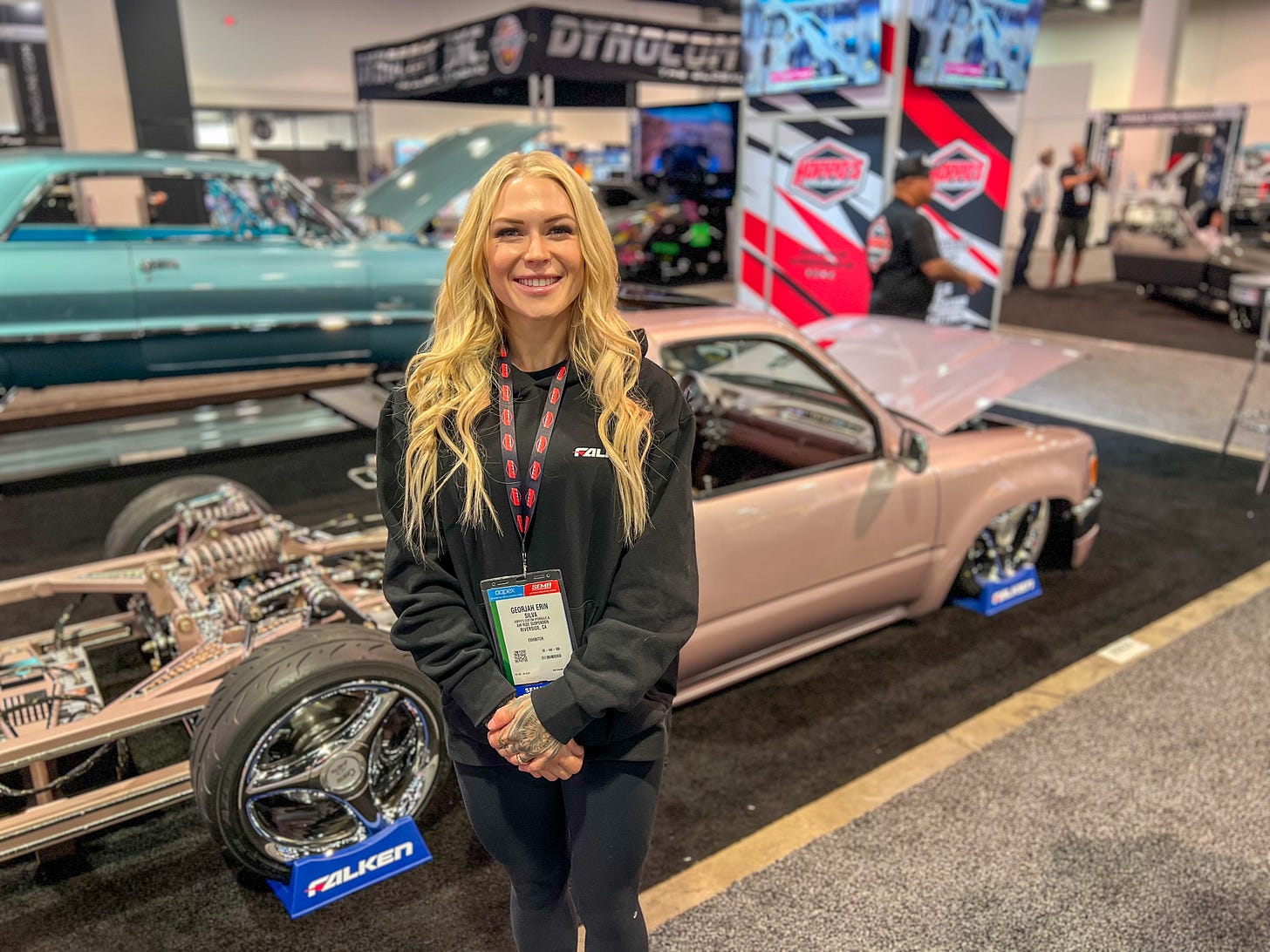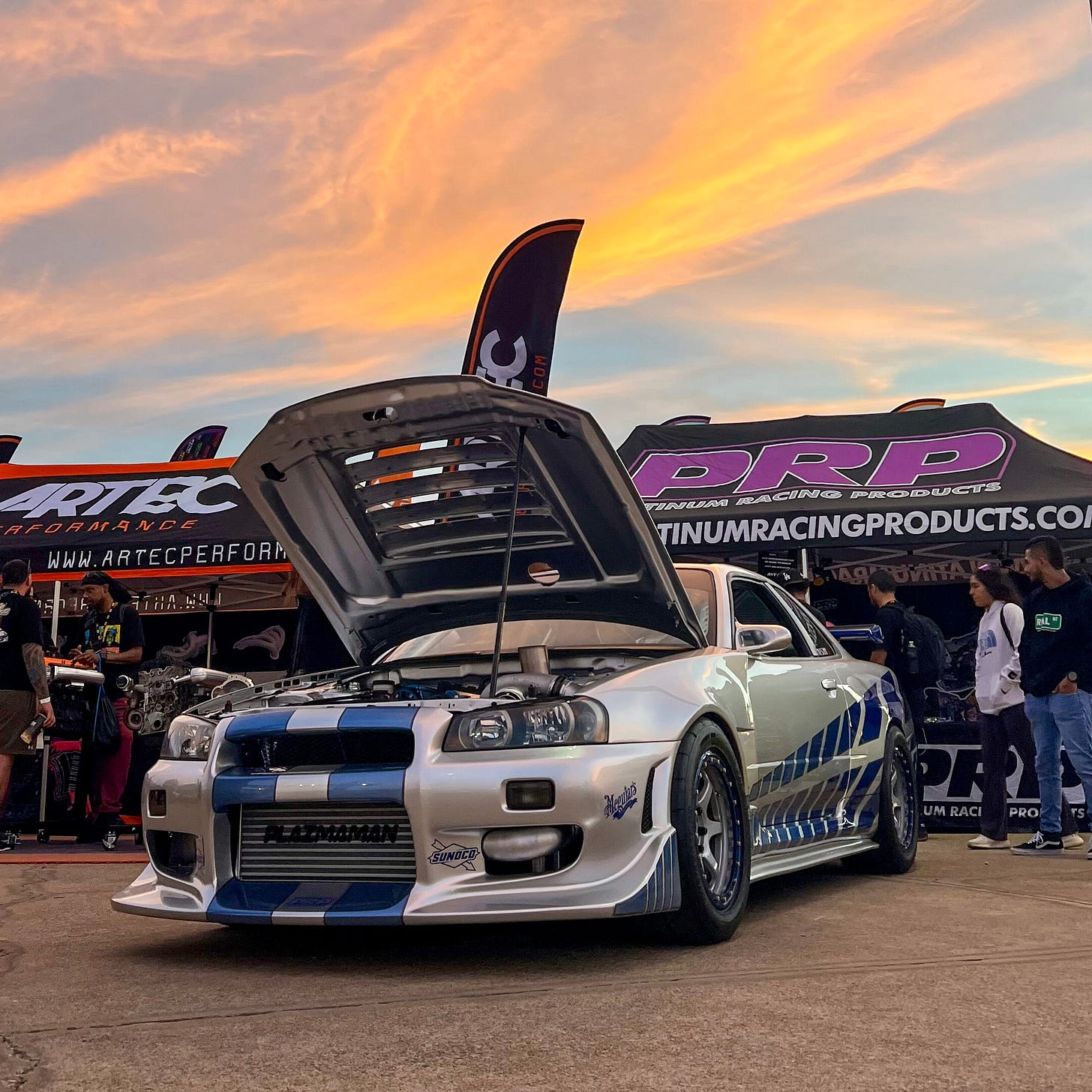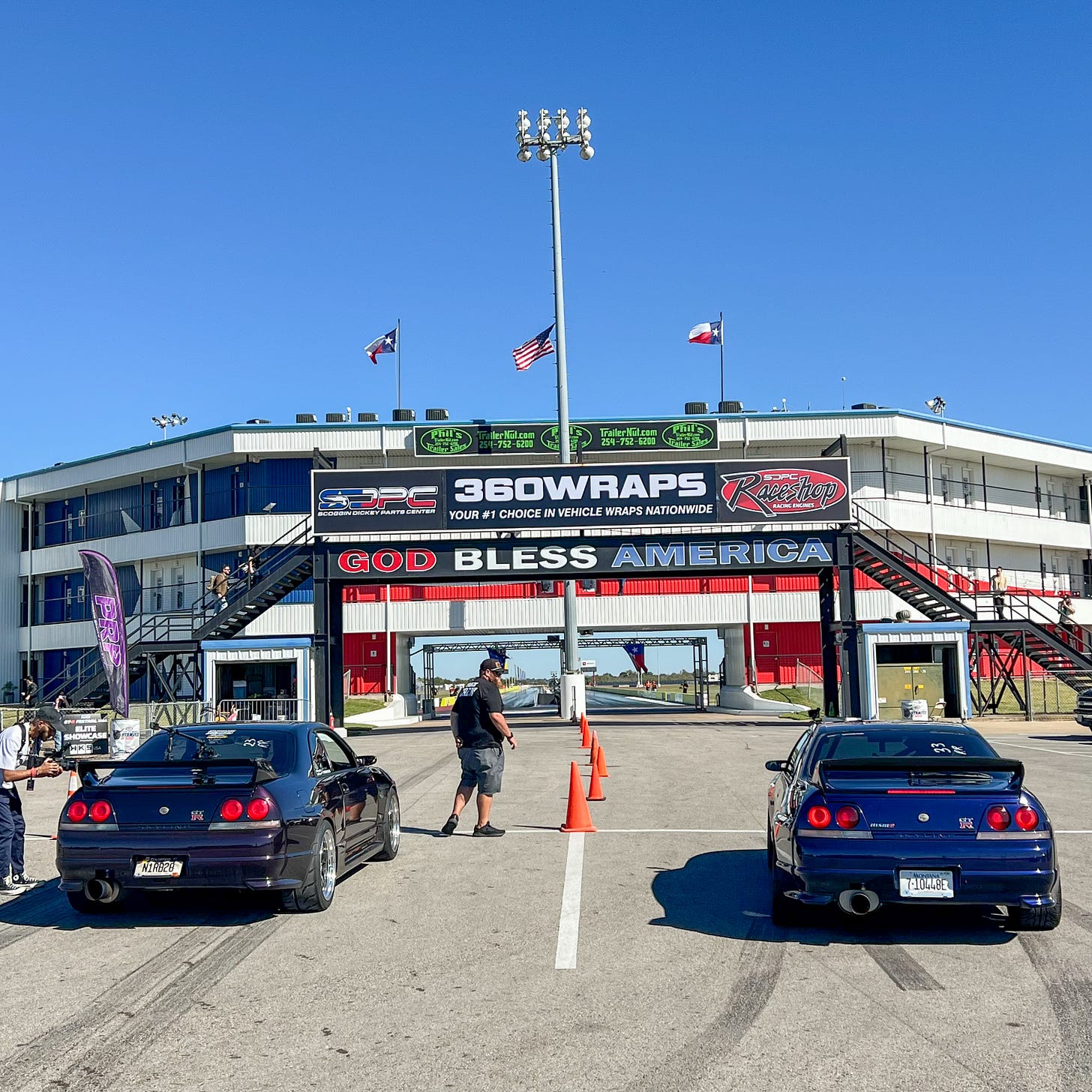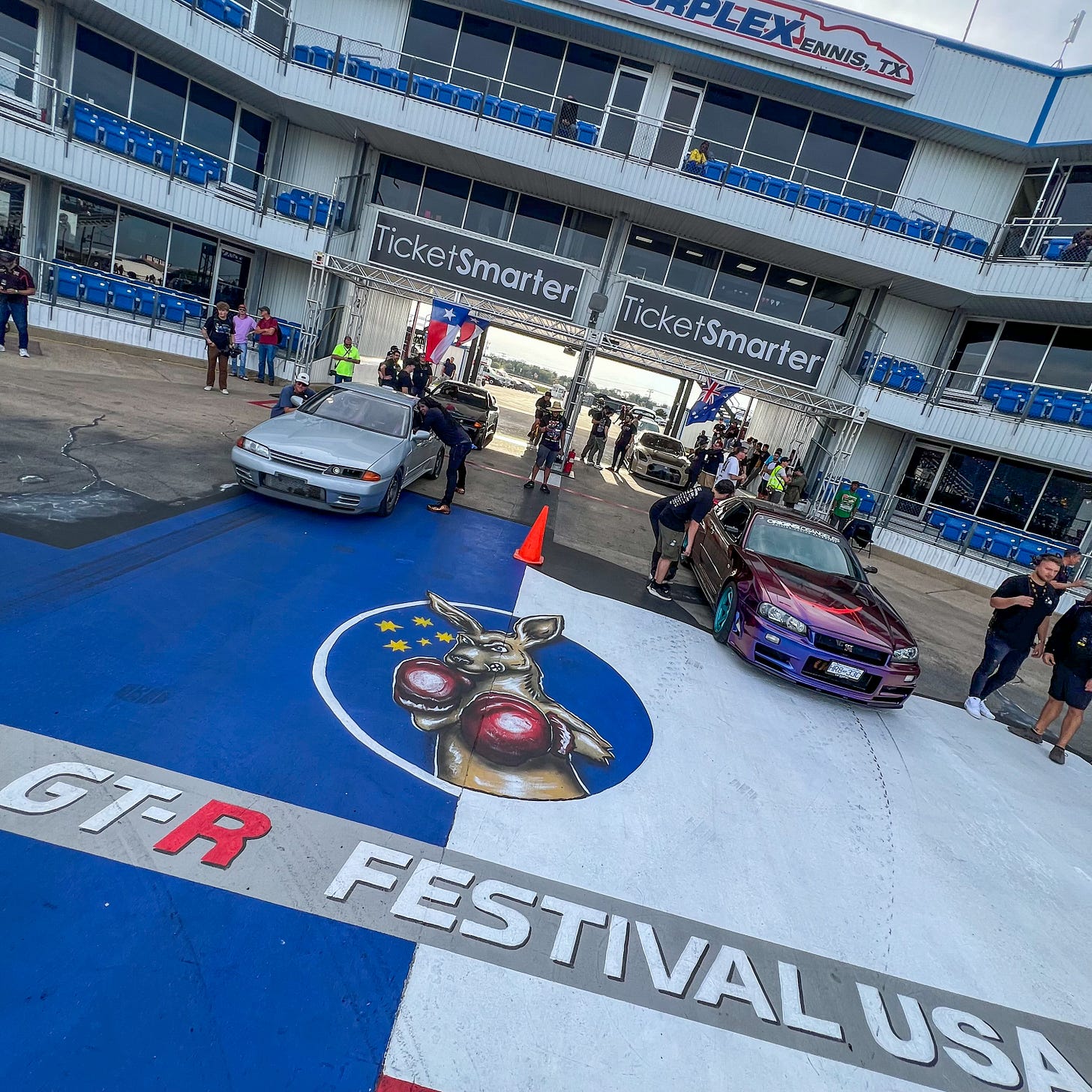GT-R Festival Will Return "150,000%" in 2025
The inaugural celebration of all things Skyline GT-R proved a smash in Texas.
HAPPY RACE DAY! especially to Georjah Erin and her ballin’ Toyota truck called “Tofu.” We interviewed Georjah for our pre-SEMA article here, when she was “panicked and stressed” about hitting the deadline for the show.
When we caught up in Vegas, she was all smiles. Tofu was a hit, and brought a ton of attention to Hoppo’s Custom Suspension which performed most of the work. When I asked Georjah if it was all worth it, she took a big sigh and replied, “Absolutely.”
You can find the finale of her YouTube series on the build here, and Larry Chen’s walkaround video on Tofu right here.
Link Central
You may have a bad day, but at least a moose didn’t break into your garage.
Racer Magazine launched a new podcast and the first guest is Will Buxton.
Former Autoblog staffers also launched a podcast called Notablog.
Motor Trend is shuttering its popular show Roadkill after 13 seasons. New episodes will air over the next two years, and MT tried to save face with an explanation. Still, a reminder that nothing is sacred.
Here’s this week’s top story.
Feature Article
The Triumph of GT-R Festival
You couldn't script a more unlikely scenario.
A bunch of Australians celebrating Japanese cars in the middle of Texas.
Yet that's exactly what brought people to remote Ennis, as the inaugural GT-R Festival stormed into the Texas Motorplex and promptly took over.
As if this were normal.
The truth is that this event—and the car, and its biggest fans—was anything but a guarantee. Nissan Skyline GT-Rs were effectively banned from entering the United States for a quarter-century, barring Americans from owning one of the most desirable cars in the world. Forget driving one or even seeing one in person—the vast majority of people in the U.S. never even knew this car existed.
Australians have had it since day one. They took this 25-year head start and began writing their own GT-R story filled with innovative engineering, motorsport dominance, and earth shattering performance on the street that even rivaled the master craftsmen of Japan.
In Japan, the GT-R is celebrated as a national icon. In the U.S. it's been a forbidden object of desire. In Australia, it's simply been a heap of fun. They've held GT-R festivals down under for 10 years, but last year, the two principal organizers, a YouTube channel called Motive Video and the aftermarket brand Platinum Racing Products, decided to cross the Pacific and bring it to the states.
Their timing couldn't have been more perfect. GT-R fandom in the U.S. has reached a fever pitch. The three most coveted models have slowly legalized over the years and are almost fully legal. Demand has never been higher. Interest has never been higher. Prices have never been higher.
So the opportunity to step in a world where this once non-existent car is now taking center stage was impossible to pass on for many. People who stake their livings on the GT-R and its customers came from California or trailored their cars from Florida. I spoke to a proud owner from Oklahoma who told me the whereabouts of every single Skyline in the state. I spoke with a drag racer from North Dakota, who’s part of a Skyline community centered in Nebraska. Festival organizers said that people came from 49 states, and traveled in from Germany, Finland and Istanbul. Among others.
But it's Texas that may write the next chapter in GT-R history. Shops are popping up to service growing Skyline communities in Houston, and some of the most famous and biggest-money cars in existence are finding their way to Dallas. PRP itself is in the process of opening a satellite office just outside the city to establish a permanent foothold in America. This would have been unthinkable until only recently. I spoke with one attendee who served on a military base in Texas in the 1990s and said that owning a Japanese sports car was grounds for getting beat up.
Today, though, it's the Lone Star State that played welcoming host to the biggest group of GT-R fanatics this country has ever seen. These cars are now old enough to qualify for vintage classification, and the rarity makes each one truly precious. You wouldn't know it by watching what people did to them in Texas. One by one, these cars lined up at the drag strip and their owners masochistically wrung every bit of combustion possible out of their hallowed RB engines.
They screamed up and down the drag strip for three solid days and broke with alarming regularity. Track workers prepped an incredibly sticky track that punished 35-year-old parts. Cars broke over and over. Pistons blew and transmission gears exploded. And one by one, their owners replaced the parts and got back in line.
It wasn’t just drag racing. GT-R Festival had drifting, dyno demonstrations and celebrities like the “Father of the GT-R” himself, Nissan ambassador Hiroshi Tamura, who had a crowd following him all weekend and must have been asked to sign two dozen cars—as if he’d won an Oscar and a Super Bowl at once.
As the weekend wound down I spoke with organizer Andrew Hawkins. He’s been hosting the GT-R Festival in Australia for a decade, and said the crowd and the enthusiasm at the first-ever U.S. event was nearly on the same level. “I’m over the moon,” Hawkins said. “One-hundred and fifty thousand percent, we’re coming back.”
To me, the festival represented more than just GT-R fanboys. The GT-R Festival was the ultimate expression of this moment in car culture. The way modern enthusiasts enjoy cars includes a wide variety of forms and styles. They want a celebration of the past and the present. They want preserved classics and modern innovations. They want high-speed drag racing, hot laps on a track, and sideways smokey drifting. The festival combined motorsport with a circus-like atmosphere. It was combining Gran Turismo with the spirit of Radwood and the attitude of Gridlife.
It was also the grand arrival of Australians on the U.S. GT-R scene. Companies like PRP, Artec and others are signaling they recognize the size of the American market and its appetite for these cars. The fact they’re willing to shift attention from Down Under to the states shows they consider this more than a fad, or a phenomenon. The GT-R market in America is legitimate big-money business, driven by dream car fantasies from the ‘90s.
It couldn’t be more unlikely. But the GT-R Festival proved it’s very, very real.
And Finally…
Did you miss our SEMA coverage? We published four newsletters in total, and you can click here to see them all.
You can also listen to them—in a way. I decided to experiment with an AI-generated podcast that sums up all of my recent reporting on SEMA and the automotive aftermarket. If reading four pieces sounds exhausting, give this a listen:
Do we love it? Hate it? I’m genuinely curious. Sound off in the comments!
Thanks for reading. Please consider sharing our newsletter with your friends.
Check out Carrara Media on Instagram, Twitter and Facebook and visit our store to order one of our many fine books and eBooks.







